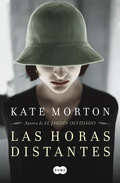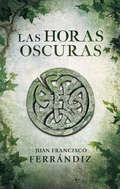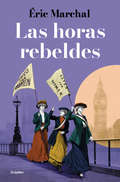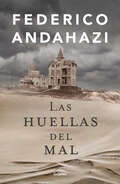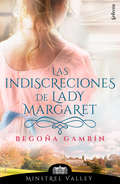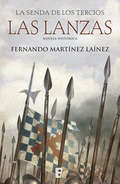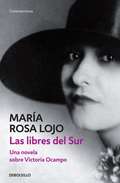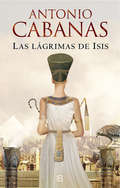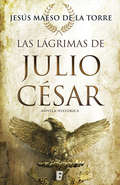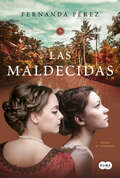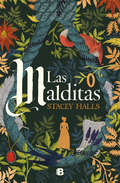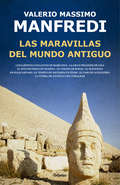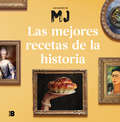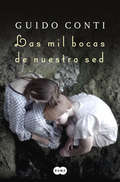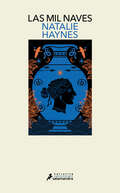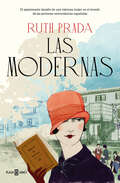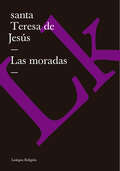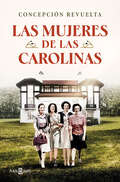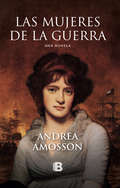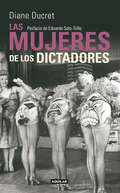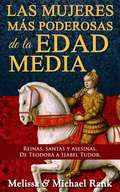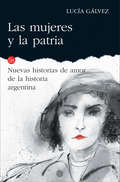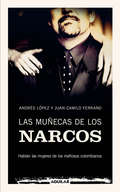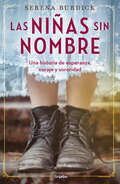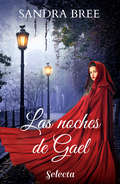- Table View
- List View
Las horas distantes
by Kate MortonTodo comenzó con una carta. Una carta que llevaba extraviada mucho tiempo, esperando durante más de medio siglo en una saca de correos olvidada en el oscuro desván de una anodina casa de Londres... De la autora de El jardín olvidado, cuyas ventas en el mundo superan los 4 millones de ejemplares vendidos, y La casa de Riverton, com más de 2 millones de ejemplares vendidos. Edie Burchill y su madre nunca han estado lo que se dice unidas. Pero un domingo por la tarde llega a su casa una carta, perdida hace tiempo, con el remite de Milderhurst Castle, en Kent (Inglaterra), y Edie empieza a pensar que la frialdad de su madre oculta un antiguo secreto. Durante la Segunda Guerra Mundial, la madre de Edie fue evacuada de Londres y acogida por la misteriosa Juniper Blythe en Milderhurst Castle, donde vivía con sus hermanas gemelas y su padre, Raymond, autor del clásico infantil La verdadera historia del Hombre de Barro. El espléndido y enorme castillo le muestra un nuevo mundo en el que descubre la fantasía y el placer de los libros, pero también sus peligros. Cincuenta años más tarde, cuando Edie busca las respuestas al enigma de su madre, se siente atraída por Milderhurst Castle, donde, ya ancianas, las excéntricas gemelas y Juniper viven todavía. En el ya ruinoso castillo, Edie investiga el pasado de su madre. Pero hay otros secretos escondidos entre sus muros, y Edie está a punto de averiguar más de lo que esperaba. Lo que realmente sucedió en las horas distantes ha estado aguardando mucho tiempo a que alguien lo desvelara. Con un estilo cautivador y una elegante manera de narrar que nos remite a Dickens, las hermanas Brönte y Jane Austen, Kate Morton da una vuelta de tuerca a la novela clásica victoriana para sumergirnos en una trama absorbente y componer un puzle tan hermoso como brillante. Reseñas:«Memorias, intriga y secretos de familia entretejidos en un absorbente laberinto de tramas complementarias que nos arrastran a una lectura llena de fuerza, ternura y emoción. Con un estilo ágil y envolvente, Kate Morton nos conmueve con una magnífica historia difícil de olvidar.»María Dueñas «Una apasionante novela de misterio y amor. [...] Las respuestas dejarán a los lectores atónitos.»Publishers Weekly «En la tradición de las novelas góticas clásicas, Las horas distantes es un cautivador viaje, un misterio cuyas revelaciones, muy bien dosificadas, proporcionan una lectura sorprendente y profundamente gratificante.»Booklist «Kate Morton, [...] en la tradición de literatura clásica anglosajona, es el último fenómeno literario. [...] Atrapa a los lectores con lazo por su manera de contar gustosa, minuciosa, victoriana.»El País Semanal «Entre sus páginas se oyen ecos del mejor Maupassant, el lejano Bradbury y sus tormentas internas y el psicológico Henry James y sus personajes inquietantes. Pero, sobre todo, Morton ha dado vida a un territorio mítico e incognoscible: la posesión más valiosa del ser humano: los recuerdos.»Ángeles López, Qué leer
Las horas oscuras
by Juan Francisco FerrándizAtrévete a descubrir la verdad que desató una terrible maldición de muerte y sombras en un tiempo de tinieblas. Conoces la leyenda, deja que te cuente ahora la verdadera historia... Cuentan los ancianos que hace mucho tiempo, en los albores del fin del milenio, un forastero llegó a las brumosas tierras de Irlanda con una misteriosa misión. Dicen que ese hombre, un monje atormentado y valeroso llamado Brian de Liébana, huía de unos caballeros de tez pálida y alma oscura, cuyo nombre nadie osa pronunciar sin santiguarse. Los más viejos afirman que Brian y sus compañeros se atrevieron a reconstruir el monasterio de San Columbano, antaño escenario de una cruel matanza. Y aunque algunos juran que profanar esas ruinas supuso el inicio de todas las desgracias, otros opinan que fue la presencia intramuros de una hermosa mujer celta lo que provocó la ira de Dios. Reseñas:«Las horas oscuras, una novela que homenajea sin complejos la emblemática El nombre de la rosa de Eco, a la que añade una dosis de fantasía estilo Tolkien.»El Mundo «La fuerza del elemento arquitectónico en construcción -el monasterio- traza vínculos con Ken Follett e Ildefonso Falcones.»La Vanguardia
Las horas rebeldes
by Eric MarchalUna vibrante novela, ambientada en la Inglaterra tradicional de principios del siglo XX, que rinde tributo a quienes se rebelaron por sus ideales y, en especial, a aquellas pioneras que lucharon por los derechos de las mujeres. Londres, 1908. A pesar de la tirantez que se respira bajo el reinado de Eduardo VI, en las calles londinenses late el germen de la revolución. Mientras el viejo mundo se aferra a sus costumbres, una joven y valiente sufragista, un atractivo médico mestizo y un excéntrico aristócrata se dejan la piel para defender sus ideales de igualdad entre hombres y mujeres, entre ricos y pobres. En su arriesgado camino hacia una sociedad más justa, se enfrentarán a dos enemigos en apariencia imbatibles: el poder establecido y un misterioso personaje apodado El Apóstol. Una novela de aventuras de un trío de rebeldes que luchan frente al poder establecido y que tienen como causa el feminismo y la justicia social. Reseñas:«Un descubrimiento absoluto.»Le Point «Éric Marchal es el Ken Follett francés.»Le Figaro
Las huellas del mal
by Federico Andahazi1892. Dos misteriosos agentes de la policía federal llegan al pueblo de Quequén, en la costa atlántica argentina, para resolver un crimen macabro. Uno de ellos es Juan Vucetich, padre de la dactiloscopia. En esta novela, Federico Andahazi retrata con afinada precisión el clima turbulento, expectante e innovador que se vivía a las puertas del siglo XX en nuestro país. Un policial oscuro, erudito y atrapante. Corre el año 1892. Argentina es una nación joven, pero se encuentra entre las más pujantes y desarrolladas del mundo. Dos misteriosos agentes de la policía federal llegan al pueblo de Quequén, en la costa atlántica, para ayudar a resolver un crimen. Dos niños han sido degollados y su madre, viva, aunque en estado catatónico, es la única testigo del hecho. Uno de los agentes es Juan Vucetich, un inmigrante de origen croata que trae un método innovador: la dactiloscopia, una disciplina que permite identificar inequívocamente a una persona por el relieve único de las crestas capilares de los dedos de la mano. Si lograran resolver un crimen tan horroroso gracias a este procedimiento, Argentina tomaría la delantera geopolítica con un logro revolucionario para la administración de los países. Con gran capacidad narrativa y una afinada precisión para describir el clima turbulento, expectante e innovador que se vivía a las puertas del siglo XX, Federico Andahazi creó una historia oscura y atrapante que indaga en personajes tan frágiles y complejos como valientes. Persecuciones, corrupción, intrigas internacionales y bandidos revolucionarios recorren las páginas de esta novela en la que se amalgaman de forma erudita y delicada, el disfrute y la reflexión.
Las indiscreciones de lady Margaret (Minstrel Valley #Volumen 12)
by Begoña GambínContinúa la rompedora serie de «Minstrel Valley», creada por catorce autoras de Selecta. Ambientada en la Inglaterra de la Regencia en un pequeño pueblo de Hertfordshire, descubrirás una historia llena de amor, aventuras y pasión. A veces el amor consigue romper las barreras que uno mismo se impone. Pese a que lady Margaret Ashbourn sabe que tarde o temprano debe casarse, entre sus prioridades no está encadenarse a un hombre de por vida. Para ella, caer rendida ante el amor es una trampa revestida de felicidad y cuyo pago es la libertad. Pero la atracción que empieza a sentir por ciertos besos ocultos tras una máscara la confunden. Andrew Kaye, vizconde Ditton, es uno de los jóvenes más perseguido y deseado por las jóvenes casaderas de Londres. Sin embargo él, en secreto, solo tiene ojos para Margaret. La atracción que sientepor ella ha ido creciendo en intensidad a lo largo de los años. Pero cuando por fin se decide a manifestar sus sentimientos, alguien se interpone entre él y su enamorada. ¿Conseguirá el amor romper los muros que rodean el corazón de lady Margaret? ¿Podrá él atrapar lo que más ha anhelado en su vida? Sobre la serie:Minstrel Valley es un proyecto novedoso, rompedor y sorprendente. Catorce mujeres que crean una serie de novelas gracias a una minuciosa organización que ha llevado tiempo y esfuerzo, pero que tiene su recompensa materializada en estas quince novelas que vamos a disfrutar a lo largo de esta temporada. Esta labor de comunicación entre ellas, el apoyo mutuo, la coordinación y coherencia no hubiese sido posible sin nuestras queridas autoras, que hacen visible que con cariño, tiempo robado a sus momentos de ocio, de descanso y de familia, confianza, paciencia, esmero y talento, todo sea posible. Desde Selecta os invitamos a adentraros en Minstrel Valley y que disfrutéis, tanto como nosotros, de esta maravillosa serie de regencia. Prólogo de Nieves Hidalgo en Si me lo pide el corazón (Minstrel Valley 1):«Serán novelas divertidas, románticas, dulces, plenas de sentimiento, con personajes que os enamorarán; hasta con leyenda incluida. Historias paridas por la imaginación de unas autoras merecedoras de elogio, no ya solo por su capacidad para ilusionarnos, su disposición a compartir sino, sobre todo, por la manera encomiable de aplicarse al trabajo para ofreceros lo mejor de sí mismas.»En los blogs...«La novela tiene muchos encuentros entre nuestros protagonistas que tienen su punto picante. [...] Me ha gustado el carácter de Margaret porque se aparta de la norma de las mujeres de la época. Quiere ser independiente y tener libertad.Las indiscreciones de lady Margaret es un libro que se lee rápido y fácil con una historia bonita y entrañable con la que seguir volviendo de visita a Minstrel Valley otro mes más.»Blog Nadie está solo «Las indiscreciones de lady Margaret de Begoña Gambín es un romance forjado a fuego lento en el que dos personas deberán dejar de lado una amistad para profundizar en unos sentimientos que siempre han existidoMargaret y Andrew están hechos el uno para le otro, pero el miedo a perder su propia identidad hará que la joven rechace un amor sincero, algo que no detendrá al vizconde pues le demostrará una y otra vez lo que es la verdadera felicidad.»Blog Promesas de amor
Las lanzas (La senda de los Tercios #1)
by Fernando Martínez LaínezFernando Martínez Laínez novela en esta serie la historia de uno de los ejércitos más importantes de todos los tiempos: los Tercios de Flandes, un ejército que marcó un hito en la historia militar universal. «La senda de los Tercios» es una obra con una labor de documentación impresionante y de rigor histórico colosal. «Ante todo era un soldado, y en las banderas, con sus camaradas, pasó sus mejores años. De soldado, tal como había vivido, pensaba fenecer, pobre y solitario, pero honrado. Todo lo honrado que se puede ser después de haber luchado en Flandes.» Las lanzas narra el primer tercio de la guerra de Flandes, centrándose en dos personajes principales: un soldado de nombre Alonso de Montenegro y el general Ambrosio Spínola. La historia del primero comienza cuando, con solo diecisiete años, se alista para huir de las consecuencias de dos crímenes desangre. Conocía a Federico Spínola, hermano de Ambrosio, de su época de estudiante, y este lo hace llamar para que sirva a su mando. Federico pretendía llevar la guerra hasta Inglaterra, pero muere sin poner en práctica su plan. Ambrosio Spínola siempre ha envidiado la inteligencia y capacidad de su hermano menor, y se propone emularlo. Toma bajo su mando a Montenegro y dirige una serie de campañas, muchas de ellas con éxito, pero lidiando siempre con la falta de recursos, sobre todo económicos. Fernando Martínez Laínez relata en esta historia novelada las hazañas de los legendarios Tercios en campañas tan relevantes en la historia militar española como las de Ostende, Frisia y Breda.
Las libres del Sur: Una novela sobre Victoria Ocampo
by María Rosa LojoEsta novela histórica retrata un momento cultural determinante en la Argentina, la década de los veinte, y la gesta de un grupo de mujeres independientes (Victoria Ocampo, María Rosa Oliver) que no solo deben propiciarse un destino, sino batallar diariamente para que aquello que acaban de conquistar no les sea quitado por su condición femenina. «Una novela que se interna por paisajes radiantes de la inteligencia humana y por los paisajes reales de esta tierra nuestra que allá por los años 20 y 30 conservaban mucho de su fuerza indómita, al igual que la joven Victoria.» Luisa Valenzuela A partir de la figura de Victoria Ocampo y desde la mirada extranjera de Carmen Brey, María Rosa Lojo abandona los caminos trillados para retratar a unos personajes y a una época que el lugar común ha cristalizado sin cuestionar ni valorar en su justa medida; Y para construir una ficción histórica ejemplar, donde la investigación y la imaginación confluyen en una escritura impecable y luminosa.
Las lágrimas de Isis
by Antonio CabanasDescubre a la reina más fascinante del Antiguo Egipto. Por el autor de los best sellers El ladrón de tumbas y La conjura del faraón. La novela que más de 300.000 lectores estaban esperando. Esta es la historia de una mujer que desafió el orden establecido para convertirse en el faraón más poderoso de Egipto. Gobernó en el momento de máximo esplendor del país, cuando su ejército era el más fuerte del mundo y el reino disfrutaba de gran prosperidad. Y dejó un inmenso legado en forma de obras arquitectónicas que hoy en día nos siguen fascinando. Con rigor y un estilo tan mágico como el tiempo que retrata, Antonio Cabanas nos sumerge en su vida: su infancia, marcada por la influencia de su abuela Nefertary; su primera juventud, en la que sufrió la preeminencia de sus hermanos sobre ella; y su etapa posterior cuando, convencida de sus cualidades para gobernar, persiguió sus ambiciones con la ayuda del sacerdote y arquitecto real Senenmut. Él fue su cómplice en las intrigas palaciegas y juntos vivieron una apasionante historia de amor que ha trascendido hasta nuestros días. Una novela magistral en la que el Antiguo Egipto se despliega ante nuestros ojos en toda su grandeza a través de una de sus protagonistas más carismáticas.
Las lágrimas de Julio César
by Jesús Maeso de la Torre<P>Una visión clara y amena de la trayectoria de uno de los personajes más fascinantes de la historia de Roma: Julio César. <P>Las lágrimas de Julio César es una palpitante novela que recrea la intensa relación de Julio César con Hispania, tomando como punto de partida su llegada a la península Ibérica en el año 68 a. C. Cónsul, dictador, eficaz estratega e ilustrado gobernante, César alentó sus sueños políticos en la ciudad aliada de Gades, desde la cual se reconstruye la historia del estadista, su destino, sus fantasías, sus victorias, obsesiones y afectos. En Las lágrimas de Julio César se recorre el mundo conocido, de Roma a Britania, de la Galia a Egipto y de Grecia a Tapsos, en el norte de África, evocando el fascinante ambiente de las más florecientes ciudades del Mediterráneo. <P>Con un estilo narrativo ágil y un contenido histórico riguroso, Jesús Maeso de la Torre deleita al lector con la vida del líder militar y político y de la profetisa Arsinoe, que lo acompañará a Roma y resolverá, en un final de vértigo, el misterioso asesinato de su madre, la gran sacerdotisa del templo de Anteo, en Tingis. <P>Un sugerente elenco de personajes ficticios y reales, como Pompeyo, Catón, Craso, Marco Antonio, Lépido, Bruto, Octavio, Bogud de Mauritania, Cleopatra, la exótica reina africana Eunoë, la amada hija de César, Julia, Calpurnia, su esposa, y Servilia, su amante, además de intrigantes senadores de la decadente República, articulan un apasionante relato sobre el ascenso, vida y asesinato de uno de los más controvertidos personajes de la Historia. <P>«Yo, Arsinoe, sibila de Gades, conocí a Cayo Julio César cuando solo era un oscuro cuestor de Hispania y acudió a mi templo a que le interpretara un sueño que mortificaba su alma. Desde aquella visita no me separé de su estela, hasta el día en el que cayó en la emboscada de la muerte y su cadáver fue incinerado en el Foro de Roma, ante millares de arrebatados romanos.»
Las maldecidas: Edición 10.° aniversario
by Fernanda PérezEdición décimo aniversario de la primera novela de Fernanda Pérez, Las maldecidas con dos nuevos capítulos como bonus track. Visitación, Desolación, Lucía y Piedad, las hermanas Rojas, son bien conocidas en el pueblo. Su madre, viuda, las educa y las prepara para la difícil vida que les espera en los parajes del norte argentino, en la frontera entre Corrientes y Misiones. Son los años de la independencia, a principios del siglo XIX. Las repúblicas americanas tratan de emanciparse de la corona española, pero a la vez deben lidiar con las distintas facciones y movimientos políticos en el interior del país. El joven Andrés Guacurarí, indio guaraní protegido del líder independentista José Gervasio Artigas y que llega a convertirse en comandante general, se prepara para la guerra y también para el amor. Su deslumbramiento por Lucía, las idas y vueltas y las batallas recorren esta historia llena de pasiones prohibidas y enfrentamientos, solidaridad y aventura.
Las malditas
by Stacey HallsEn un tiempo de miedo y sospechas ser mujer es el mayor de los riesgos. Solo ellas saben la verdad. Solo ellas pueden salvarse la una a la otra. Fleetwood Shuttleworth tiene diecisiete años, está casada y embarazada por cuarta vez. Como señora de Gawthorpe Hall, en el condado de Lancaster, todavía no ha conseguido traer al mundo un bebé que sobreviva al parto y su esposo Richard es eso precisamente lo que más ansía: un heredero. Cuando Fleetwood descubre una carta oculta del médico que la atendió en su último embarazo, sabe que es ella quien no sobrevivirá esta vez. Pero entonces su camino se cruza con el de Alice Gray, una jovencísima partera y curandera que le promete que le la ayudará a dar a luz a un bebé sano, el heredero que todos esperan y que convertirá a Fleetwood, por fin, en auténtica señora de su la mansión y sus las tierras. Sin embargo, el rey Jacobo I, consciente de que el condado de Lancaster se ha convertido en un nido de conspiradores, sabe que una buena manera de instaurar el orden es infundir miedo y temor entre sus habitantes. Y así arranca la caza de brujas más terrible de la historia de Inglaterra, una caza en la que cualquier joven con conocimientos médicos se vuelve sospechosa. Conforme el juicio de las brujas de Pendle se acerca, Fleetwood y Alice saben que se necesitan la una a la otra para sobrevivir. La crítica ha dicho:«Una recreación rica y atmosférica de un periodo histórico lleno de tensiones religiosas, supersticiones, misoginia y miedos.»The New York Times «El ritmo trepidante de Hall hechiza.»The Times «Un brillante debut, rápido y original , de la mano de una nueva voz de enorme talento.»The Daily Telegraph «Una investigación meticulosa, una hermosa escritura.»Cosmopolitan
Las maravillas del mundo antiguo
by Valerio Massimo ManfrediUn fascinante recorrido por las maravillas del mundo antiguo, sus secretos, la realidad y las leyendas que las han acompañado, de la mano del Manfredi arqueólogo, apasionado por su profesión, riguroso y excelente divulgador. Los jardines que un rey hizo construir para su amada. Una tumba desmesurada para un solo hombre. Un dios con carne de marfil y ropajes de oro, sentado en su trono. Una estatua de bronce de treinta y dos metros de altura, el desafío de un discípulo a su inalcanzable maestro. El espectacular sepulcro rodeado de columnas de un reyezuelo presuntuoso. El templo más grande jamás construido, erigido para la diosa. Una torre en una islita cuya luz guiaba a los navegantes desorientados en la noche. Los jardines colgantes de Babilonia, la gran pirámide de Guiza, el Zeus de Fidias, el coloso de Rodas, el mausoleo de Halicarnaso, el templo de Artemisa y el faro de Alejandría. Son las obras más impresionantes de la Antigüedad, el orgullo de las grandes civilizaciones del pasado, que aún hoy encienden nuestra imaginación. A ellas Manfredi suma otra, menos conocida e igualmente excepcional: la tumba-santuario de Antíoco I en la cima de una montaña de Turquía. Valerio Massimo Manfredi es internacionalmente conocido como el gran autor de novela histórica sobre el mundo antiguo. Entre sus títulos más conocidos están la trilogía Aléxandros, La última legión, El tirano, El imperio de los dragones,El ejército perdido, Los idus de marzo, Odiseo. El juramento y Odiseo. El retorno. Pero Manfredi también es arqueólogo, especializado en arqueología clásica. Ha impartido clases en universidades de Italia y de otros países. Ha conducido numerosas excavaciones y ha publicado artículos y ensayos académicos, además de colaborar en periódicos y revistas. Ha escrito y dirigido documentales sobre la Antigüedad para las cadenas más importantes de televisión. Toda esta enorme dedicación a un tema que le apasiona se concentra ahora en Las maravillas del mundo antiguo, donde nos invita a viajar por la Historia y a conocer a quienes la vivieron y la estudian. Reseña:«Una narración poderosa y magnética que ofrece la posibilidad de visitar con los ojos de la mente esas maravillas, esas obras que desafiaban lo imposible.»Modena Today
Las mejores recetas de la historia
by María José Martínez (Las recetas de MJ)Más de 30 personajes históricos, más de 30 recetas deliciosas. El nuevo libro de María José Martínez combinará historia universal y gastronomía. El mejor regalo para los amantes de la gastronomía y la historia. ¿Cuál era el dulce preferido de María Antonieta? ¿Con qué sabores se deleitaban los atenienses de la época de Alejandro Magno? ¿Disfrutaron Cleopatra y Julio César de un clásico pan romano cuando se conocieron? ¿Le habría gustado a Juana de Arco la sopa de cebolla a la alsaciana? ¿Y cuál era el plato mexicano por excelencia de Frida Kahlo? María José Martínez -creadora del exitoso canal de YouTube Las recetas de MJ- nos ofrece un libro para aprender y degustar. A través de treinta historias, la autora repasa los personajes más destacados de cada siglo, y también homenajea a todos esos sabores, ingredientes y descubrimientos culinarios que han surgido en diversas partes del mundo. Gracias a las recetas que acompañan cada capítulo, podrás probar el cocido favorito de Cristóbal Colón, empezar el día como un genio desayunando lo mismo que Albert Einstein o preparar un célebre plato mexicano siguiendo la receta que usaba Frida Kahlo.
Las mil bocas de nuestra sed: Un amor distinto y prohibido que resistió el tiempo y la distancia
by Guido ContiUn viaje del pasado al presente, desde la burguesía provinciana hasta la ciudad y desde el cuerpo hasta lo más profundo de la psicología humana. En 1946, en una Italia marcada por los terrores de la guerra recién terminada, las jóvenes Emma y Marzia entablan una amistad que se acabará transformando en un amor absoluto, pero prohibido por los prejuicios y las convenciones sociales del entorno burgués en el que viven. Juntas descubren el placer del sexo y la ternura de la confidencia. Son conscientes de la inconveniencia de sus sentimientos y tratan de llevar su relación en secreto, al margen de sus familias. Pero cuando todo se descubre, sus padres se oponen, castigándolas con severidad y alejándolas definitivamente. Marzia se va a vivir a Argentina, mientras Emma es enviada a Londres; veinte años después, un giro del destino hará que se reencuentren. El destino es un círculo que acaba cerrándose siempre... No existen días inútiles en nuestra vida. Reseñas:«El autor intenta [...] contar historias que atrapen al lector, apasionarlo, avivar sus sentimientos, hacerlo correr a través de las páginas en un carrusel de emociones, que incluye aventuras y momentos de amor, descripciones líricas y acción, diálogo y situaciones de ternura y violencia».La Repubblica «Las mil bocas de nuestra sed vuelve a expresar la delicada pero tenaz estructura psicológica de las contradicciones interiores entre las pequeñas heroicidades, las infinitas debilidades, la languidez burguesa y los devastadores insultos de las ocasiones en una tormenta silenciosa, aunque feroz, y saturada de sí misma».Gazzeta di Parma «Las mil bocas de nuestra sed entra en una dimensión ambiental y narrativa completamente distinta, dado que la fogosa pasión amorosa que atenaza a las jóvenes Marzia y Emma las acompaña desde el verano de 1946 a 1968, del inicio en el campo y en unas ciudades pequeñas que se describen con la indefinición y la imperceptibilidad del simple contrapunto natural al amor a Tellaro, Roma, Patagonia y Buenos Aires».Corriere della Sera «En la línea de una amplia tradición literaria, Conti logra brindarnos un refinado cuadro de análisis psicológico de los personajes a la vez que mantiene el gusto y la sobriedad, y evita las abstracciones y las concesiones a ciertas morbosidades, ya mecánicas, de la literatura de género, que ha acabado degenerando en un obsoleto conformismo».Il Cittadino
Las mil naves
by Natalie HaynesUna novela magistral sobre la guerra de Troya desde una perspectiva femenina. «Ésta nunca ha sido la historia de una mujer, ni de dos: es la de todas.» En plena noche, una mujer se despierta y observa que su amada ciudad está envuelta en llamas. Los diez años de conflicto entre griegos y troyanos, que parecían no tener fin, quedan atrás, con Troya reducida a cenizas. Desde las mujeres troyanas, cuyos destinos ahora están en manos de los griegos, hasta la princesa amazona que, en nombre de ellas, luchó contra Aquiles, pasando por Penélope, que espera el regreso de Ulises, o las tres diosas con cuya contienda empezó todo... Éstas son las fabulosas historias de unas mujeres envueltas en una guerra legendaria y marcadas por sus terribles secuelas. La crítica ha dicho...«Con la pasión que la caracteriza, su ingenio y un feminismo intenso, Natalie Haynes dota de una voz realmente necesaria a las mujeres silenciadas de la guerra de Troya.»Madeline Miller, autora de Circe «Absorbente y de un feminismo valiente. [...] Su revisión original de los clásicos es una delicia de múltiples capas.»The Guardian «Haynes es una maestra de su oficio. [...] Consigue insuflar pasión vital a algunas de nuestras leyendas más antiguas para demostrar cómo han cambiado las relaciones humanas y las emociones más elementales.»The Telegraph «Una historia feminista ingeniosa sobre el sufrimiento, el coraje y la entereza de las mujeres. La frescura de la versión moderna de Haynes de una historia antigua es perfecta para nuestros tiempos.»Booklist «Esta vívida reinvención [de la Guerra de Troya] bien vale el viaje.»Library Journal «Una apasionante obra maestra del feminismo.»Deborah Frances-White, The Guilty Feminist «Este libro no se limita a reconocer el sufrimiento de las mujeres. De manera vívida, cuenta apasionantes historias de coraje, traición y venganza.»The Washington Post «Hábil y muy bien tramada. [...] A través de detalles muy evocativos, Haynes consigue recrear de forma admirable la vida de las mujeres griegas y troyanas.»The New York Times «Un relato cautivador de las vidas de las mujeres de las culturas troyana y griega. [...] Haynes reconstruye con brillantez la visión establecida de la guerra de Troya para plasmar las experiencias de las mujeres.»Publishers Weekly
Las modernas
by Ruth PradaUna evocadora novela sobre los retos que tuvieron que afrontar las primeras universitarias españolas. 1928. Catalina viaja a Madrid contra la voluntad de su madre para estudiar Farmacia y se instala en la Residencia de Señoritas. Su ilusión, su pasión y sus ganas de aprender pronto la llevarán a hacer nuevas amigas, a verse envuelta en los conflictos políticos de la época y a entrar en contacto con iconos feministas como Elena Fortún y María de Maeztu. Su viaje de adolescente ingenua a mujer con deseos propios se verá marcado por un triángulo sentimental con dos jóvenes que representan mundos opuestos y, sobre todo, por las dudas entre el matrimonio y su vocación profesional. Porque, en esa época, una mujer sí debía elegir. ¿Conseguirá Catalina hacer realidad su mayor deseo? Sobre el contexto histórico de la novela: En 1915 se creó la Residencia de Señoritas, apenas cinco años después de que las mujeres consiguieran el derecho a matricularse libremente en una universidad. Que las chicas ocuparan las aulas era algo insólito y objeto de críticas; María de Maeztu, la directora de la Residencia durante los 21 años que existió, lo dejó escrito de esta manera: «El camino no puede ser más áspero y a veces las espinas me quitan la salud, pero la finalidad me parece cada vez más certera y luminosa». De Maeztu puso todo su empeño en conseguir que las jóvenes de cualquier rincón del país tuvieran la oportunidad de recibir una educación superior y pudieran incorporarse al mundo laborar como profesionales. Pero la formación que recibieron las alumnas que pasaron por la Residencia fue mucho más allá del aspecto académico: las reuniones para el intercambio de ideas, los viajes culturales, las conferencias, la educación física y los intercambios con colleges femeninos de Estados Unidos también formaron parte del plan educativo. La mayoría de las pioneras del primer tercio del siglo XX estuvieron vinculadas con la Residencia: María Zambrano, Maruja Mallo, Victoria Kent, Josefina Carabias, Delhy Tejero, Clara Campoamor, Zenobia Campubrí, Gabriela Mistral o Concha Méndez, fueron algunas entre otras muchas.
Las moradas
by Santa Teresa de JesúsLas moradas is the main text of Santa Teresa, describing a journey through the mysteries of the spirit in search of enlightenment.
Las mujeres de Las Carolinas
by Concepción RevueltaLa nueva novela de Concepción Revuelta nos traslada al Santander de la Guerra Civil para narrarnos la historia de cuatro mujeres que deben afrontar un futuro convulso con fortaleza y valor. 1935: la Segunda República ha traído avances para la situación profesional de las mujeres en todo el país. Pero, en los albores de la Guerra Civil, eso está a punto de cambiar drásticamente. A las puertas del conflicto bélico, cuatro jóvenes de diferente condición y estrato social forjan una amistad en la famosa casa de las Carolinas, en Santander: Gloria y Laura, enfermeras que se sienten impotentesante el dolor físico y la injusticia; Susana, una valiente cocinera que nunca quiso destacar, pero que se verá obligada a ello; y Ana, una estudiante de derecho que ejercerá de periodista para denunciar los atropellos a la clase obrera. La nueva y fascinante novela de Concepción Revuelta nos traslada al Santander de la Guerra Civil para narrarnos lahistoria de cuatro mujeres que deberán afrontar, con entereza y valor, la amenaza de sus aspiraciones y hasta de sus vidas. Las mujeres de las Carolinas es una historiaapasionante de fortaleza, coraje y sacrificio, con uno de los episodios más convulsos de nuestra historia como telón de fondo. Concepción Revuelta (Santander) se asomó al mundo literario con la publicación del cuento infantil Los Pegimun. Unos años más tarde dio el salto a la novela adulta con Aromas de tabaco y mar, que relata la vidade una cigarrera santanderina en los años cincuenta. En 2019 publicó en Plaza & Janés su segunda novela, Te di mi palabra, sobre la historia de las pasiegas empleadas como amasde cría por nobles y burgueses. A esta la siguió Días grises con cielo azul dos años después. Las mujeres de las Carolinas es su tercera novela en Plaza & Janés.
Las mujeres de la guerra
by Andrea AmossonUna novela de mujeres empoderadas que deciden tomar el protagonismo en plena Guerra del Pacífico Vera Ninkovic llegó a Chile siguiendo a su esposo, un naturalista norteamericano fascinado con las aves del fin del mundo. En estas tierras la pilló una guerra que no era la suya pero que se parecía a la furia que vivió en los Balcanes. Vera compró un periódico en Iquique, amobló una casa, crio un hijo y se preparó, como pudo, para la catástrofe que nubló su horizonte y el de un grupo de mujeres #Mercedes, Jacinta, la Changa, Silvia# de distinto origen pero el mismo ímpetu: enfrentar la lógica de un conflicto sangriento que no tuvo piedad alguna ni en el mar ni en la tierra. La escritora Andrea Amosson construye, de manera ágil y con sorprendente destreza narrativa, una novela histórica que transcurre en plena Guerra del Pacífico y que pone en primer plano a las heroínas olvidadas de esta y de todas las guerras: las mujeres, aquellas que sostienen la vida misma contra toda lógica cuando se ha desatado el horror en el frente.
Las mujeres de los dictadores
by Diane Ducret¿Cómo explicar el capital de seducción de los dictadores sobre unas mujeres educadas en independientes como son las europeas de principios del siglo XX? Ellos son Lenin, Mussolini, Stalin, Hitler, Salazar, Mao, Ceaucescu, Bokassa, Franco. Ellas se llaman Inessa, Clara, Nadia, Magda, Felismina, Jiang Qing, Elena, Catherine, Sofía, Carmen... No importa si son mujeres de vida alegre, intelectuales, aventureras o amantes apasionadas, ellos siempre recurren a ellas y caen en sus redes de seducción. Esposas, compañeras, musas, admiradoras, tienen en común haber permanecido al lado de hombres crueles, violentos, tiránicos e infieles a quienes sin embargo amaban con vehemencia. Ellas compartieron su vida con los dictadores más terribles del siglo pasado a pesar del engaño, del poder devastador de la política, de los espías, de las críticas, de las rivales... porque estaban fascinadas y porque los necesitaban tanto como ellos. La autora de documentales y presentadora Diane Ducret, haciendo gala de un estilo periodístico riguroso y objetivo, plantea en Las mujeres de los dictadores un recorrido histórico por unos idilios amorosos que son la crónica política de nuestro pasado más reciente. Los enamoramientos, las relaciones amorosas, la persuasión, el papel en los regímenes totalitarios y los diferentes destinos, a menudo trágicos, de las mujeres que pasaron por la cama de algunos de los hombres más despóticos de la pasada centuria. Una lección de historia magistral.
Las mujeres más poderosas de la Edad Media: reinas, santas y asesinas. De Teodora a Isabel Tudor.
by Michael Rank Melisa Arancibia Melissa RankUna historia biográfica de las 10 mujeres más poderosas de la Edad Media La idea de una mujer poderosa en la Edad Media parece una contradicción. Imaginamos que las mujeres en aquella época eran señoritas en apuros, atrapadas en una torre y esperando a que su caballero la rescatara mientras llevaba un cono de tráfico por sombrero. Una vez rescatadas, sus vidas comenzaban a mejorar aunque sus posibilidades de elección eran limitadas; ser una reina dócil, ama de casa o quemada en la hoguera por bruja. ¿Pero qué pasaría si dijéramos que la imagen que tenemos de mujer medieval es pura ficción? Resulta que lo es. La Edad Media está repleta de reinas poderosas. Lady Ethelfleda dirigió ejércitos en combate directo con los vikingos y salvó a Inglaterra de la invasión extranjera. La emperatriz Teodora evitó la caída del Imperio Bizantino durante los grandes levantamientos y frenó la huida de su marido y del consejo de Constantinopla. Catalina de Siena restauró el papado en Roma prácticamente sin ayuda de nadie y fue una de las pocas personas que pudo negociar con todas las partes del divisivo y despiadado mundo de la política italiana. Juana de Arco cambió por completo la suerte de Francia en la Guerra de los Cien Años y lideró asaltos a las fortalezas inglesas aún siendo una campesina analfabeta de 17 años. A lo largo de este libro echaremos un ojo a las vidas de diez de las mujeres más importantes de la Edad Media, ya sea la popular erudita Ana Comneno, Margarita I de Dinamarca, la unificadora de Escandinavia o la Reina Madre otomana Kösem Sultan, que dirigió el Imperio Islámico a través de tres de sus descendientes. Todas estas mujeres alcanzaron un nivel increíble de poder en un momento en el que las mujeres no tenían nada. Analizaremos cómo consiguieron alcanzar el poder, la importancia de los logros obtenidos y el impacto que causaron en sus respectivas sociedades incluso después de
Las mujeres y la patria
by Lucía GálvezCon textos sencillos y cautivantes, cimentados en una investigación histórica rigurosa, Lucía Gálvez nos demuestra que las mujeres siguen siendo grandes protagonistas silenciadas de nuestra historia. Una vez más, la historiadora Lucía Gálvez nos demuestra con estas narraciones que, conocidas o no, las mujeres siguen siendo grandes protagonistas silenciadas de nuestra historia. En algunos casos, sus vidas y sus actos permanecen en el olvido; en otros, su fama ha servido muchas veces para ocultar o tergiversar el verdadero sentido de sus acciones. Las mujeres y la patria rescata la importancia histórica de personajes como Micaela Bastidas, Mariquita Sánchez, Remedios Escalada, Encarnación Ezcurra, Delfina Bunge y Victoria Ocampo, entre otras, a través de una recorrida por sus afectos, sus amores, sus sacrificios y sus renunciamientos en el marco de la azarosa evolución de nuestro país.
Las muñecas de los narcos: Hablan las mujeres de los mafiosos colombianos
by Andrés LópezLas muñecas de los narcos recoge por primera vez el testimonio de seis esposas de mafiosos colombianos. Brenda, Violeta, Noelia, Pamela, Renata, Frida... Probablemente estos nombres no significan nada para ti, en este momento, ahora que tienes este libro entre las manos; sin embargo, sus historias merecen ser leídas. Las seis son originarias del Valle del Cauca y esto no es casualidad. En este distrito colombiano arraigó con gran fuerza el narcotráfico. Brenda, Violeta, Noelia, Pamela, Renata, Frida comparten algo más: conviven a diario con peligrosos narcos. Son esposas, amantes, madres, pero por encima de todo son mujeres. Por primera vez dan la cara para contar cuál es la realidad de sus vidas, su historia de amor, lo que ven, lo que sienten, lo que callan, las operaciones de estética que necesitan para conquistar el paraíso, la humillación y sus palabras son un torrente de sucesos fuera de todo orden. Elex narcotraficante y escritor Andrés López y el periodista Juan Camilo Ferrand nos ofrecen en Las muñecas de los narcos seis desgarradores testimonios de las mujeres de los mafiosos de la droga para mostrar que la felicidad no la dan las grandes sumas de dinero ni el poder. Éste es el relato del narcotráfico contado por sus mujeres y desconocido hasta ahora. Éstas son las muñecas de los narcos. Así es como suena su voz. Hoy por fin tienen la palabra.
Las niñas sin nombre
by Serena BurdickCuando las sufragistas se manifestaban en las calles de Nueva York y los sindicalistas luchaban por unas condiciones de trabajo dignas, a las chicas descarriadas las encerraban en la Casa de la Misericordia. Cerca de la mansión familiar de Luella y Effie Tildon se cierne la Casa de la Misericordia, una institución para mujeres caídas en desgracia, mujeres consideradas indignas de vivir en sociedad. Bajo esa sombra amenazadora, las hermanas crecen sabiendo que, incluso para jóvenes acomodadas como ellas, la libertad tiene límites muy estrictos. Todo cambia cuando juntas descubren un secreto familiar escandaloso y Luella, la mayor y más atrevida, decide que ella tiene derecho a hacer lo que le plazca. El día que Luella desaparece misteriosamente, Effie sospecha que su padre ha cumplido la amenaza de ingresarla en la Casa de la Misericordia, así que elabora un plan para salvarla. Sin embargo, comete un error y nadie cree su historia. A partir de ese momento, el destino de Effie estará en manos de Mable, una enigmática compañera de encierro. De la incipiente amistad y la confianza entre ambas dependerán sus posibilidades de sobrevivir. Una historia de esperanza, coraje y sororidad, inspirada en la Casa de la Misericordia y las mujeres allí confinadas. «Burdick ha escrito una fábula sobre lucha y supervivencia, amor y familia, y, sobre todo, sobre la fuerza del corazón, por roto que esté.»New York Times Book Review «La narrativa combina una prosa exuberante, con una trama ágil y fascinante.»Publishers Weekly «Un thriller fascinante para amantes de las historias de principios de siglo XX.»Kirkus Review «Giros de trama, impactos emocionales y un ritmo cada vez más acelerado, hacen que Las niñas sin nombre resulte apasionante.»BookBrowse «La historia de supervivencia y tránsito a la madurez de Burdick, ambientada en Nueva York a principios del siglo XX, es una lectura obligada.»Historical Novel Society
Las noches de Gael
by Sandra BreeUna historia de amor y aventura ambientada en la fascinante época de la regencia. Una nueva y apasionante novela de Sandra Bree, autora de Un geo para mi body. Gael Roswet necesita descubrir si existe más gente, aparte de ella, que haya heredado un don extraño y peculiar. Para ello viaja a Londres, porque en una ciudad tan aglomerada no debe ser difícil averiguarlo. El problema le sobreviene cuando, sin pensarlo, salva al conde de Silverstone de morir asesinado. Darren Wentfield O´Rourke, conde de Silverstone, es alto, guapo..., sus facciones son perfectas. Sin embargo, toda aquella belleza que tanto atrae también intimidaba. La culpa la tiene su apostura soberbia, implacable y arrogante. Es el tipo de hombre con el que Gael podría marcharse al fin del mundo y perderse en un apasionado romance y, a un tiempo, romperle la crisma con saña. O tal vez... ambas cosas.
